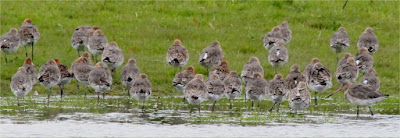The weather forecast reckoned it was going to be less bad as you head North so I got an old man's explorer ticket and bobbed up to Leighton Moss.
 |
| Spadglings |
Just as I was about to go out the first of this year's spadglings descended on the garden. It's always nice to see them.
Waiting for the train at Humphrey Park six of the local swifts made their first group appearance, coinciding with the start of the rain. Up till now it's been ones or twos round here. There were a dozen more at Trafford Park Station.
As the train approached Silverdale I could see there were plenty of black-headed gulls and shelducks on the coastal pools. There were also seven sleeping spoonbills opposite the Eric Morecambe Hide and a great white egret on the railway embankment.
Leighton Moss was busier than last time, understandably, but not uncomfortably so. It was a nice sunny day, too. I skipped the Sky Tower this time, that was too busy.
 |
| Leighton Moss |
I walked down to the reedbed hides. Chiffchaffs sang near the visitor centre, willow warblers sang further out where the willows were sparser and mostly younger. I hadn't gone far when I bumped into a marsh tit and a treecreeper feeding on the same mossy tree branch, both of which were quite unconcerned about my standing ten feet away, both of which hid behind the branch every time the camera focussed on them. Four or five reed warblers were holding singing territories.
The first marsh harrier of the day floated high over the reedbeds carrying what looked like a large vole or small rat, then it flew back the way it came. I'd assumed it was carrying food for chicks but perhaps it was by way of being a packed lunch. The harrier was loosely escorted by black-headed gulls while a few dozen swifts weaved in between the bodies.
Tim Jackson Hide was open and quiet so I spent a while there. Fifty-odd black-headed gulls looked to be nesting in the far pool behind the bund, a couple of pairs of lapwings put on displays though it would seem a bit reckless for them to have any young so close to a gull colony. There were also half a dozen black-tailed godwits in various stages of mottled rusty. The near pools were quiet save a family of coot, a pair of gadwall and a few mallard.
 |
| Greylags |
There were a couple of families of greylags on Griesdale Hide, together with a nesting mute swan and more coots and gadwall. Half a dozen drake shovelers wheeled round the pools before flying off towards the causeway, probably because they had nothing better to do.
The walk back down to Lilian's Hide was punctuated by more reed warblers, swifts and black-headed gulls. A family of coots fussed around in the ditch under the bridge while a water rail gave a full-bodied gut-wrenching squeal from the reeds nearby. Nearer the hide I was mugged by a couple of blue tits and a great tit but I didn't have any mealworms on me.
 |
| Black-headed gull |
The black-headed gulls at Lilian's Hide had at least two dozen nests between them. There's too many for the rafts so there are nests scattered round the reed edges, which possibly explains why the mallards were camped out deep in the reeds. A pair of pochard emerged from the reeds at the far side but it didn't look like they had any ducklings with them. Similarly the raft of tufted ducks.
It was starting to get more busy so I called it quits. I'd had a couple of hours' wander and I wanted to quit while I was still enjoying it.
I got the Barrow train as far as Dalton — I wanted to have a look over the Kent and Leven estuaries and there's a ten-minute connection with the Manchester Airport train at Dalton.
There weren't many waders on the open mud on the Kent Estuary – most are away on their breeding quarters this time of year. A few oystercatchers and a couple of curlews were all I could see. A few more families of greylags peppered the marshes on the Grange side of the estuary. The marshes between Cark and the Leven Estuary were littered with little egrets, they'd been few and far between up to then. The flock of seventeen eiders loafing on the mud on the banks of the Leven brought the year list up to 150. On the way back, sitting on the other side of the train, there were another couple of dozen eiders upstream of the railway bridge. A little further on I noticed some goosanders on a pond on the approach to Cark.
Thence home, via Stoke on Trent to max out the value of my ticket.




















































